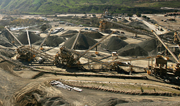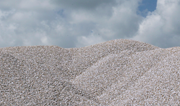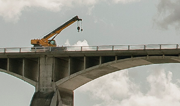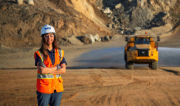Social Responsibility
The Quarry Story
The Story of How a Quarry Works
Unless you’ve visited or toured a quarry, chances are you don’t know much about what goes on inside one. In the simplest terms, a rock quarry is a place where little rocks are made from big rocks. Although the basic process is the same, each quarry is different and some of the things in Quarry Story may not apply to all operations. Geography, geology and the type of stone mined, how close a quarry is to neighbors, the size of the operation and the main transportation method used to get the stone products to customers all have an impact on how each quarry is designed and operated.
At Vulcan Materials Company, our primary business is quarry mining. We take big rocks out of quarries and make smaller rocks and sand by crushing them. We sell the crushed rock and sand to builders and contractors who use them to build roads, highways, bridges, houses, shopping malls, schools, churches and other buildings and structures.
Words that are highlighted in the Quarry Story are defined at the end.
Finding, Preparing and Designing a Site
Before we can start operating a quarry many preparations must be made. First, our geologists must find a place where there is a large supply of rocks beneath the earth’s surface. We mine igneous, metamorphic, and sedimentary rocks to be used for construction. A quarry is frequently located near a community where our products are needed because if it isn’t, it will cost our customers too much to haul the crushed stone, which is very heavy, over long distances.
Obtaining Permits
After we find a good place to put a quarry, our geologists survey the land, and we develop a design that will make our quarry safe and efficient. Then, we have to get a variety of operating permits from local, state and federal governments. For instance, to obtain the environmental permits, it is necessary to provide a plan that shows we can and will obey all environmental rules of the state and federal governments. Once we obtain the proper permits, equipment is purchased, roads are built to the facility and we begin building the processing plant.
Being A Good Neighbor
It is very important to us that we operate as a good neighbor in the communities where we build quarries. For example, at many sites we create buffer zones around the quarry so noise is kept to a minimum. We landscape the entrance to the quarry so that it blends with the surrounding area. We install special water systems so we can recycle the water we use in processing, and we put in many other features to protect the health and safety of our employees and our neighbors.
Being Good Environmental Stewards
Great care is also taken to protect the environment and the animals that live on our quarry lands. A quarry site might be as big as 600 or more acres, but, only a small part of that land is actually used for the quarry and processing plant. We often establish wildlife habitats in the buffer zones to attract and protect animals that might live around our quarries. At some locations we have also built parks, nature trails and ball fields in buffer zones. Our quarries are full of so many interesting things that they are often seen as huge outdoor classrooms where students can come to see what we do and learn about earth science and nature. Once we decide where to put a quarry, we prepare the site for quarrying.
Preparing the Site
In order to get to the rock beneath the surface of the earth, we have to clear the land we are going to mine. Once we have the land prepared we are ready to begin mining rock. At many sites, the material that is removed is used to begin construction of berms and other buffer areas, or donated for landscaping or construction projects in the community.
Getting Rocks out of the Earth
Drilling and blasting is a very important part of how we get rocks out of the earth. We design this process around how much rock we want to break apart, the type of rock we are working with and the size pieces we want to break off. We hire experts to help with drilling and blasting because they know exactly how to work with explosives to make sure this part of the process is handled safely, efficiently and as quietly as possible.
First, holes are drilled in the earth and explosives are placed inside. The explosives are detonated to provide the smallest release of energy for the most efficient blast. The entire blasting process occurs in just a few seconds. Larger quarries may blast once a day and smaller quarries may blast once or twice a week. Blasting is monitored with a special machine to record sound and vibrations so that the community around our quarry remains protected and safe.
The blasts that occur when the explosives are set off free the stone from the quarry wall. The big pieces are removed by pit loaders and dumped into large haul trucks.
Loading Rocks and Hauling Rocks From the Pit
The area that begins to form out of the earth when we blast away big pieces of rock becomes the quarry or pit. We use very large haul trucks to load and move the rocks out of the pit and to the processing plant where they are crushed and divided into different sizes. Trucks move back and forth between the pit and the processing plant.
Now that we have the rocks out of the ground and moved over to the processing plant, we begin turning big rocks into little rocks.
Breaking Rocks
When trucks deliver the big pieces of rock to the processing plant, the rocks are put into a primary crusher that will break them into smaller pieces. The primary crusher can crush between 300 and 2,000 tons per hour. Depending on what size we want to make the rocks, they may be put through different kinds and smaller sizes of crushers one or two more times. As the rocks pass through the crushers, they are moved around the processing plant on conveyor belts.
Separating Rocks Into Different Sizes
After crushing, comes screening. As the rocks are broken down to smaller sizes, we use screens to separate them into piles that are the same size. Some screens are larger and they allow the bigger rocks to pass through. The smaller screens let only the small rocks through. Rocks may be crushed and screened many times before they are put in a stockpile with other rocks the same size.
Moving Rocks Around the Processing Plant
For rocks to get from one place to another at our plant, they travel on long, continuously moving conveyor belts. The conveyors help move rocks in an economical way, saving money and time.
Taking Care of Our Employees and Our Neighbors
During the entire quarrying process, we make sure that we protect the health and safety of our employees and neighbors.quarry-story--truck Mining rocks and moving rocks around a processing plant can create fine particles of dust. We control dust by using water sprays on the rocks as they are processed, and by using spraying equipment to wet quarry roads.
To protect the environment, we use water that we recycle in our own closed loop water system that collects rainwater and water that we use during processing. Water is stored in a recycling pond where the sediment is allowed to accumulate. If we have to discharge water from a recycling pond, we test the water to make sure that it is safe and that it meets environmental water quality regulations.
Storing Rocks
Stockpiles are huge piles of rock, sand, gravel and other materials, and we do mean huge. Some of our stockpiles are as much as 30 feet high and 800 feet around. They are so big that we have to keep them outside. Because they are exposed to the weather, they have to be carefully maintained so heavy rain doesn't wash them away. We also have to be careful not to let other materials get mixed in with them. We use bulldozers and front end loaders to keep the stockpiles in place. When customers come to our facility for a load of crushed stone, they go to the stockpile. We use a shipping loader to fill their trucks with the rocks and other aggregates from the stockpile.
Weighing Rocks and Trucks
Our rocks are sold by the ton. Before we can bill a customer for the materials they buy from us, we have to know the weight of each load. When trucks come to our facility, they are weighed before loading. Once they are loaded they are weighed again. Then, we subtract the weight of the empty truck from the weight of the full truck and we know how much the load weighs. This is the way we calculate how much the company has to pay for the load. Weighing is also important because it helps make sure that the trucks leaving our quarry are not too heavy for the roads they will travel on. Each state has laws that say how much weight a truck can legally carry. If a truck weighs too much, some of the material is taken off of it and then it is weighed again before it leaves the quarry.
Delivering Rocks to Where They are Needed
Most of the time customers come to our facilities and we load the materials they need onto their trucks for transport to where they need to use them. Sometimes though, the materials have to be moved over greater distances. If materials need to be moved a long way, we might use boats, trains or barges to move them.
As you can see, making little rocks out of big rocks isn’t as easy as it sounds. At Vulcan Materials Company, we work very hard to be our nation’s best and most environmentally friendly producer of construction materials. We are committed to doing things right, every day, through every step in the process of making rocks. We take important steps to make sure that our employees and neighbors are safe and the environment is protected. We hope you enjoyed learning about how a quarry operates. If you have any questions, please contact us at learning@vmcmail.com.
Vocabulary Words
- Aggregates – Rocks, sand, gravel and other materials that are used in construction.
- Berm – An earthen barrier, covered with native plants, that provides a physical and visual screen between public property and a quarry site. Berms also limit access to the site and help keep noise levels down in the community.
- Blasting – The process of using explosives to break large pieces of rock out of the earth.
- Buffer zone – An area surrounding a quarry that helps provide a visual and sound barrier between the quarry and the surrounding community. These buffers consist of naturally occurring plants and trees, planned habitats and other areas developed by Vulcan. Buffer zones often include berms.
- Closed loop water system – A system of capturing and recycling the water we use in the processing plant.
- Conveyor belt – An endless, moving, flexible belt that takes rocks from one place to another around the processing plant.
- Crushers – The machines used to break big rocks down into smaller rocks. Rocks go through several different size crushers during the processing operation.
- Crushed stone – Rock that is crushed to a specific size in a quarry processing plant.
- Discharge – Water meeting environmental standards that is allowed to leave a settling pond and go into a stream or river. Discharges usually occur only during times of extremely heavy rainfall. Water quality regulations and a quarry’s environmental permits cover water discharges.
- Drilling – The process of putting holes in the ground where explosives will be placed for blasting.
- Dust suppression – The process of reducing the amount of dust that goes into the air.
- Explosives – The material that is detonated during the blasting process to break big pieces of rock out of the earth. The explosive used in the stone industry is not dynamite, but a mixture of ammonium nitrate and diesel fuel called ANFO.
- Geologist – Someone who studies nature and the earth. Vulcan uses geologists to help decide where we should put quarries and to determine what kind of rocks are located at each site.
- Haul trucks – Trucks that haul loads of rocks from the pit to the primary crusher at the processing plant.
- Igneous rocks – A type of rock that forms from hot magma or lava that comes from deep within the earth. As it slowly cools it becomes rock such as granite, basalt, or gabbro.
- Metamorphic rocks - A type of rock that develops from the alteration of sedimentary, igneous, or other metamorphic rocks due to extreme heat and/or pressure. Some examples of metamoprhic rocks are granite gneiss (formed from granite), marble (formed from limestone), and quartzite (formed from sandstone).
- Mining – the process of digging rocks out of the earth.
- Permitting – The process of getting approval from local and state government agencies to operate a quarry.
- Pit – Another name for a quarry. A place where rocks are dug or mined out of the earth.
- Pit loader – An excavation tool that helps move the rocks from the earth into haul trucks.
- Primary crusher – The first crusher that big rocks are crushed by. The primary crusher makes the rocks small enough to go through the secondary and tertiary crushers.
- Processing plant – Where rocks from the quarry are taken to be processed into different sizes. The processing plant begins at the primary crusher.
- Quarry – A place where rocks are dug or mined out of the earth.
- Quarry wall – The boundary of the quarry, as viewed from inside the pit. Also, the part of a quarry where blasting takes place.
- Recycling pond – A place where water is stored and recycled for use in quarry operations.
- Screening – Different size screens are used to separate rocks into piles of the same size. Rocks are passed through several different size screens during processing.
- Sediment – Sand and other matter that is in the water that we recycle. Sediment is heavier than water and settles to the bottom of a recycling pond.
- Sedimentary rocks – A type of rock that develops from the consolidation of sediments that have been deposited by one of three methods of weathering. They are as follows: mechanical, chemical, or organically extracted. Some rocks formed from these processes are sandstones and shales (mechanical), limestone and dolomite (chemical ), and marl (organic).
- Shipping loader – Shipping loaders are used to put rocks into a customer’s truck.
- Stockpile – Large piles of rocks and sand where dump trucks go to pick up loads of the construction materials.
- Vibrations – Movement caused by blasting.
- Water quality regulations – Federal, state and local laws that must be met if water is allowed to flow from a quarry site into a stream or river.




